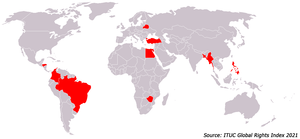Global Rights Index
| Part of a series on |
| Organized labor |
|---|
 |
The Global Rights Index is a world-wide assessment of trade union and human rights by country. Updated annually in a report issued by the International Trade Union Confederation, the index rates countries on a scale from 1 (best) through to 5+ (worst). Ratings are based on 97 indicators derived from the labour standards of the International Labour Organization.[1] The annual index reports on violations of trade union rights, such as limitations on collective bargaining and the right to strike, inhibiting trade union membership, state surveillance, violence and killings against trade unionists and restrictions on freedom of speech.[2]
Ratings
The ITUC debuted the index in 2014.[3] It uses the following rating system to indicate the extent of trade union rights violations:
| Rating | Meaning |
|---|---|
| 5+ | No guarantee of rights due to the breakdown of the rule of law |
| 5 | No guarantee of rights |
| 4 | Systematic violations of rights |
| 3 | Regular violations of rights |
| 2 | Repeated violations of rights |
| 1 | Sporadic violations of rights |
2023 rankings

According to data collected from 2023 across 149 countries, in terms of violations of trade union rights, the ITUC rated the following as the worst for working people:[4]
- Bangladesh
- Belarus
- Ecuador
- Egypt
- Eswatini
- Guatemala
- Myanmar
- The Philippines
- Tunisia
- Turkey
References
- ^ "ITUC Global Rights Index 2020 shows workers' rights violations occur too often in Central and Eastern Europe". www.ilo.org. International Labour Organization. 24 June 2020. Retrieved 29 November 2020.
- ^ "ITUC releases 2020 Global Rights Index, naming worst performing countries for protection of workers' rights - Business & Human Rights Resource Centre". www.business-humanrights.org. 23 June 2020. Retrieved 29 November 2020.
- ^ Tharoor, Ishaan (20 May 2014). "Map: The worst places in the world to be a worker". The Washington Post. Retrieved 29 November 2020.
- ^ "2023 Global Rights Index" (PDF). International Trade Union Confederation. p. 8. Retrieved 18 July 2021.
